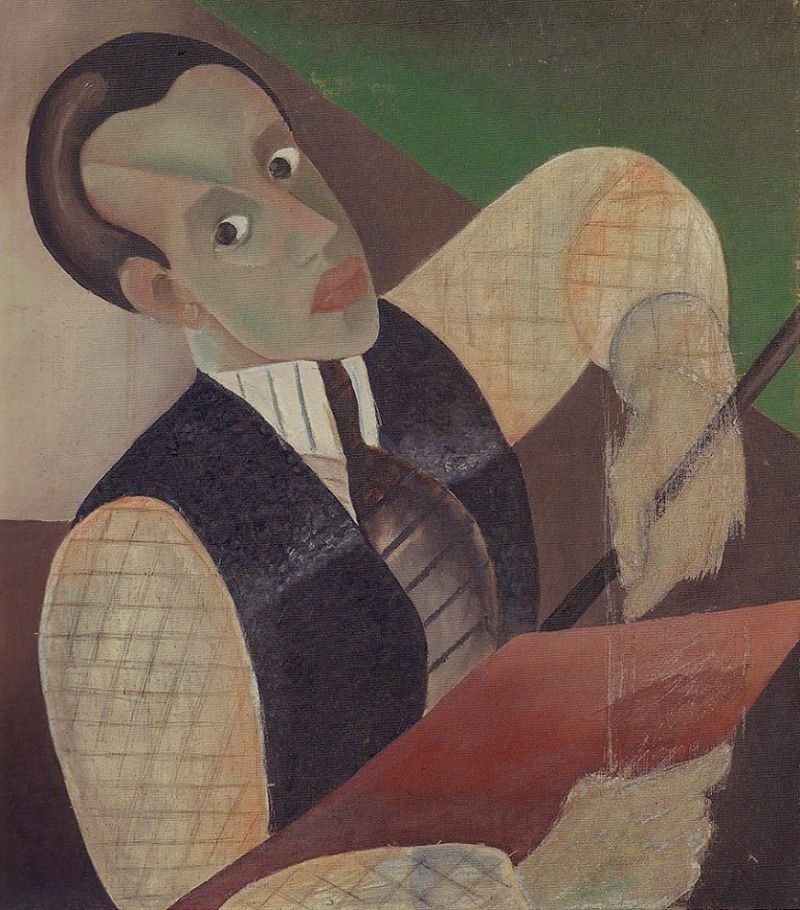Jesekiel David Kirszenbaum (1900–1954). Student of the Bauhaus





























































Diagnosed with cancer at the beginning of the 1950s, Kirszenbaum reflected on his time at the Bauhaus in a series of abstracted or complete abstract images. At first glance, two watercolours showing fish in front of abstract backgrounds (Fig. 56, 58) are reminiscent of the painting produced by Paul Klee in 1925 entitled “The Goldfish” (Hamburg Art Gallery/Hamburger Kunsthalle). The artist constructed watercolours and gouaches using abstract textures (Fig. 57) and arabesques from free organic forms, like the ones created by Mondrian and Kandinsky around 1910. The combination of figurative and free-form shapes, as seen in his watercolour of an “Abstract garden”[109], is also reminiscent of Roger Bissière, a member of the École de Paris, who in his early years also modelled his work on Klee’s style. A last recollection of Staszów, “The Prophet Elijah” (Fig. 59), follows on from the images of the Arrival of the Messiah in the shtetl, and shows the familiar folksy figures in front of the backdrop of the town. However, the prophet, not the Redeemer, becomes the main figure who, according to biblical tradition, is carried away to heaven by fiery horses (2 Kings 2, 11).
Kirszenbaum died of cancer in 1954. Retrospectives were held in 1955 in the Galerie Tsavta in Jerusalem and in 1962 in the Galerie Karl Flinker in Paris in the Rue du Bac 34. Friedrich Hagen wrote an extensive essay about the artist’s life and work in the Flinker catalogue.
Axel Feuß, October 2019
We would like to thank the great nephews of Jesekiel Kirszenbaum, Nathan and Amos Diament (Tel Aviv) for generously providing us with information, photographs and permission to reproduce the works, and we would also like to thank Ms Anna Taube (Osnabrück, formerly of the Goethe Institute, Tel Aviv) for her kind support in acquiring information.
Literature:
Yechezkel Kirszenbaum: Childhood and Youth in Staszów. From “Life Chapters of a Jewish Artist”, translated by Leonard Levin, originally in Hebrew in: Sefer Staszów (The Staszów Book), published by Elhanan Erlich, Tel Aviv 1962, page 221-229, online: https://www.jewishgen.org/yizkor/staszow/sta221.html; again in: J.D. Kirszenbaum 2013 (see below), page 129-170
Revolution and Realism. Revolutionary art in Germany 1917 to 1933, Exhibition catalogue, Berlin State Museums/Staatliche Museen zu Berlin, (East) Berlin 1978
Inna Goudz: Herwarth Walden and the Jewish artists of the Avantgarde, in: Der Sturm. Centre of the Avantgarde, Volume 2: Essays, Exhibition catalogue Von der Heydt-Museum, Wuppertal 2012, page 515-540
Johanna Linsler: Jesekiel David Kirszenbaum, between revolutionary ambition and memories of the shtetl/Jesekiel David Kirszenbaum, entre aspiration révolutionaire et mémoire du shtetl / Jesekiel David Kirszenbaum, zwischen revolutionärem Streben und Erinnerungen an das Schtetl, in: Anne Grynberg / Johanna Linsler: L’Irréparable. Itineraries of artists and amateurs of Jewish art, refugees of the “Third Reich” in France/Itinéraires d’artistes et d’amateurs d’art juifs, réfugiés du „Troisième Reich“ en France / Irreparabel. The lives of Jewish artists, and art connoisseurs on the run from the “Third Reich” in France/Lebenswege jüdischer Künstlerinnen, Künstler und Kunstkenner auf der Flucht aus dem „Dritten Reich“ in Frankreich, published by the Koordinierungsstelle Magdeburg, Magdeburg 2013, page 265-289 / 290-314
J.D. Kirszenbaum (1900-1954). The Lost Generation. From Staszów to Paris, via Weimar, Berlin and Rio de Janeiro / La génération perdue. De Staszów à Paris, via Weimar, Berlin et Rio de Janeiro, published by Nathan Diament, Paris 2013; including: Baron David de Rothschild: Alix de Rothschild: Student and Benefactor / Alix de Rothschild, élève et bienfaitrice, page 11; Nadine Nieszawer: Jechezkiel Kirszenbaum, a Jewish Artist of the School of Paris / Jechezkiel Kirszenbaum, un artiste juif de l’École de Paris, page 13-16; Nathan Diament: A Personal Pathway / Un cheminement personnel, page 21-32; Caroline Goldberg Igra: Kirszenbaum’s Artistic Journey / Le parcours artistique de Kirszenbaum, page 35-124
Caroline Goldberg Igra: The Restoration of Loss: Jechezkiel David Kirszenbaum’s Exploration of Personal Displacement, in: Ars Judaica, published by the Bar-Ilan University, Faculty of Jewish Studies, Department of Jewish Art, Nr. 10, Ramat Gan 2014, page 69-92
Nadine Nieszawer / Deborah Princ and others: Artistes juifs de l’École de Paris 1905-1939 / Jewish Artists of the School of Paris, Paris 2015, page 177 f. / 428 f., online: http://ecoledeparis.org/wp-content/uploads/2018/12/1.pdf
J.D. Kirszenbaum (1900-1954). Retrospektiva/Retrospective, exhibition catalogue Muzej Mimara/The Mimara Museum, Zagreb 2018
All electronic links were last accessed in October 2019.
Video:
On the occasion of International Holocaust Remembrance Day on January 27, the Willy Brandt Center in Jerusalem is dedicating itself to J.D. Kirszenbaum with a film: https://www.youtube.com/watch?fbclid=IwAR02r8UDCLPmFRa_SQznLW4zMTpgJG_lM7mDwYbC1kNNRoVyU09LIhnIvms&v=JsUXlvHp06I&feature=youtu.be
[109] See the Solinger exhibition in this portal, https://www.porta-polonica.de/de/atlas-der-erinnerungsorte/jesekiel-kirszenbaum-ausstellung-solingen, Fig. 26
























































































